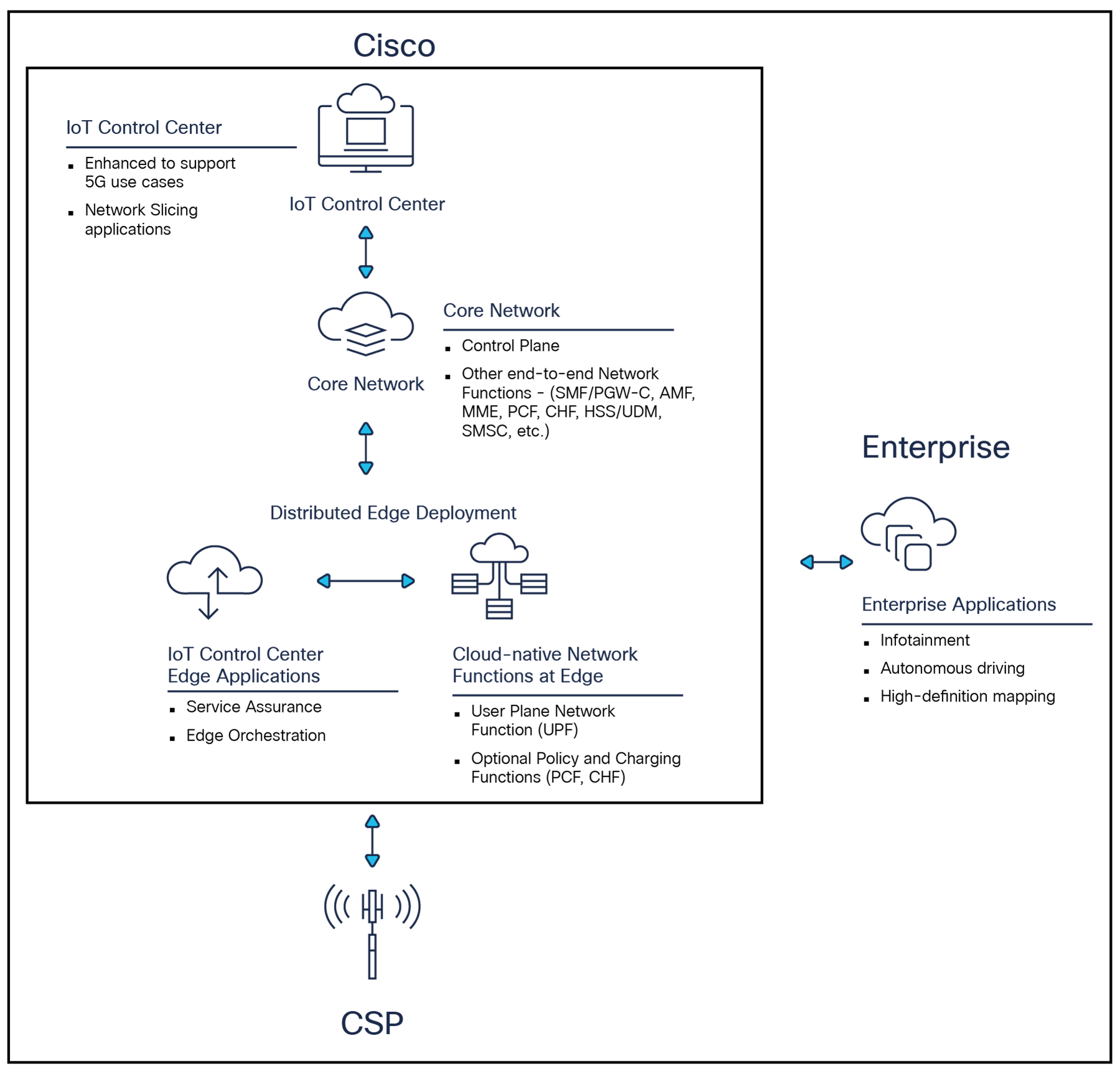Cisco IoT as a Service Solution Overview
Available Languages
Bias-Free Language
The documentation set for this product strives to use bias-free language. For the purposes of this documentation set, bias-free is defined as language that does not imply discrimination based on age, disability, gender, racial identity, ethnic identity, sexual orientation, socioeconomic status, and intersectionality. Exceptions may be present in the documentation due to language that is hardcoded in the user interfaces of the product software, language used based on RFP documentation, or language that is used by a referenced third-party product. Learn more about how Cisco is using Inclusive Language.
What if you could build a profitable enterprise Internet of Things (IoT) business—without a large capital outlay and high network management costs? You can, with Cisco IoT as a Service, delivered as a service.
Cellular IoT connectivity revenues are forecast to reach approximately €16.6 billion in 2026[1], which reflects a significant increase in enterprise revenue for Communication Service Providers (CSPs). Offering value-added IoT services diversifies revenues, making your business model more resilient. But first you need to overcome the barriers to market entry:
● High capital costs. As of 2022, US CSPs have collectively spent approximately $117 billion for the C-band spectrum [2] and $7.57 billion for the mmWave spectrum.[3] After acquiring spectrum, CSPs need to invest billions more for radio gear and deployment sites. AT&T has invested $24 billion for its 5G rollout[4] —a sum out of reach for all but the largest CSPs.
● Highly complex 5G Standalone (SA) core network deployment. Connected vehicle applications like autonomous driving, periodic mapping updates, and cellular vehicle-to-everything (C2VX) have stringent SLA requirements. To meet SLAs, network components need to be close to connected vehicles and other IoT devices—at the edge. Making sure that network functions from multiple vendors interoperate requires sophisticated orchestration and automation, and expertise is scarce.
● No easy transition from LTE to 5G. It takes a huge investment of time and resources to move IoT devices from one network to the next generation.
● Diversify revenues and win high-revenue deals
● Monetize 5G to recoup spectrum investments
● Go to market sooner
● Avoid upfront capital outlay
IoT demand is growing
By 2023, the number of global machine-to-machine connections will reach 14.7 billion. [5]
Connected car OEMs are leading the way in 5G, making them a particularly appealing target market for CSPs. For example, BMW launched 5G-enabled vehicles in China in partnership with China Unicom. [6] GM is planning to introduce 5G-enabled connected cars in the US. in 2024 and Canada in 2025. Revenue for connected car applications is expected to reach $73 billion in 2030, growing at a 30% CAGR. [7] With the right 5G IoT service, you can attract vehicle manufacturers interested in:
● Telematics and predictive maintenance
● High-definition mapping
● Software-based subscription services
● Firmware and Software updates over the air (FOTA/SOTA)
● Usage-based or OEM-led insurance offers
● Autonomous driving
● Collaboration applications that connect drivers or passengers to work
● Autonomous trucking applications like platooning, which enables trucks to safely follow each other closely to reduce air drag and improve fuel economy
The network technology is here
Innovations that enable 5G IoT services include:
● Network densification. CSPs continue to add 5G New Radio (NR) cell sites. They’re also upgrading existing Radio Access Networks (RANs) to support new 5G spectrum and dynamic spectrum sharing. Today’s denser networks support mission-critical IoT applications that depend on continuous connectivity and low latency, like autonomous driving.
● Cloud-native 5G. Deploying and managing network services is simpler with software-defined networking and virtualized, cloud-native network functions. CSPs that deploy RAN, core, and edge network functions on public clouds can take advantage of the cloud provider’s global presence to start up and scale services. Distributed deployment on Multiaccess Edge Computing (MEC) hosts support applications requiring very low latency. Your enterprise customers can reduce latency even more by deploying their IoT applications on the same MEC host as network functions.
● Network slicing. CSPs can offer differentiated mobility services as network slices with unique QoS and performance characteristics. Enterprises can use multiple dedicated or shared slices with the right characteristics for their various use cases, such as autonomous driving and infotainment. Slices can be optimized for:
◦ High traffic volume and data rates: Enhanced Mobile Broadband (eMBB)
◦ Low latency: Ultra-Reliable Low Latency Communication (URLLC)
◦ Large numbers of low-cost, low-power devices: Massive Machine-Type Communications (mMTC)
What's included and how it works
Building a 5G SA core network is a massive challenge requiring huge investments of time, R&D dollars, and specialized expertise. We've done it for you. Cisco IoT as a Service helps you introduce profitable IoT services-over 3G, LTE, and 5G SA. Delivered as a service, Cisco IoT as a Service provides the building blocks you need to launch and operate your own enterprise IoT service (Figure 1). The foundation is an end-to-end converged core network with a distributed edge deployment. You and your enterprise customers manage connectivity with Cisco IoT Control Center, an industry-leading Connectivity Management Platform (CMP) that's been enhanced for 5G.

Cisco IoT as a Service
5G Standalone (SA) converged core network functions
Cisco IoT as a Service uses cloud-native, converged core network functions—the same functions that power the world’s largest live 5G SA network. [8] This enables you to gracefully transition from 3G to 4G to 5G SA. The core network functions are containerized, meaning that you can deploy them on any edge server or cloud—private, public, or hybrid. User-Plane Functions (UPFs) can coexist with your customers’ IoT applications on the same edge servers. Coexistence substantially lowers latency by minimizing IP hops and potentially reduces costs.
Our service comes with a default network slice you can use for simple use cases. To work with connected car OEMs and offer value-added services, use Cisco IoT Control Center to create additional network slices that meet stringent performance requirements.
Network orchestration and automation stack
Keep operational costs down with automated deployment, management, and monitoring of network slices and edge nodes. Our orchestration and automation stack interoperates with our core network functions as well as your network components using 3GPP-compliant, open APIs. If some of your enterprise customers connect IoT assets that roam outside of your coverage area, like vehicles, you can make sure that your roaming partners also meet your SLA targets and ensure that slice-based services comply with standards-based definitions.
Cisco IoT Control Center
Cisco IoT Control Center is the market-leading Connectivity Management Platform (CMP), now enhanced to support 5G use cases. From a single pane of glass, your enterprise customers can deploy and manage 3G, 4G, and 5G devices at global scale. It works with all generations of wireless technology because the network core feeds it from 3GPP-compliant network interfaces that have not been customized. Enhancements for 5G include:
● Key network identifiers that help you and your enterprises differentiate your services.
● A default network slice, required for session establishment.
● Real-time session visibility, which simplifies troubleshooting. A subscriber that's live and served by the end-to-end 5G SA network is highlighted in IoT Control Center.
For more information read “Deliver 5G IoT Services Faster” White Paper
Figure 2 shows how Cisco IoT as a Service help your connected car customers deliver high-quality experiences.

Connected car OEMs get network visibility and control with Cisco IoT as a Service
Monetize 5G with IoT Control Center Charging Function
Included with Cisco IoT Control Center, the Charging Function (CHF) gives you a single point of control over the core network’s sessions, usage, and slice identifiers. It collects the information you need for rating and billing, replacing your legacy Call Detail Record (CDR) system. Generate new revenue streams by enabling enterprise customers to deploy new slices, edge capacity, or edge applications. Accurately bill connected car customers for services consumed, using our online charging and quota management features. Our CHF is fully 3GPP compliant. It interoperates with our Session Management Function and Packet Data Gateways (SMF/PGW-C) and also with network functions from other global vendors.
IoT Control Center self-service capabilities, tailored for 5G
IoT Control Center enables self-service:
● Dynamic slice-based service creation and lifecycle management
● Edge orchestration with UPF and mission-critical application deployment
● Service assurance
● Traffic classification and creation of VPN, Access Point Names (APNs), and Data Network Names (DNNs)
Cisco IoT Control Center is the leading CMP, used by:
● 50+ CSPs
● 210M+ connected devices
● 77M+ connected cars
● 2M+ new devices per month
● 2K+ enterprises
Market your IoT services to enterprises providing products or services for:
● Connected cars
● Wireless hotspots for utilities, retail, smart travel services, and critical infrastructure
● HD cameras
● Smart banking
● Gaming venues
● Telemedicine
Financing to help you achieve your objectives
Cisco Capital® can help you acquire the technology you need to achieve your objectives and stay competitive. We can help you reduce CapEx, accelerate your growth, and optimize your investment dollars and ROI. Cisco Capital financing gives you flexibility in acquiring hardware, software, services, and complementary third-party equipment. And there’s just one predictable payment. Cisco Capital is available in more than 100 countries. Learn more.
Cisco is the CMP market leader. Our global experience, reach, and track record of success are second to none. We connect more devices and connected cars than any other platform on the planet. With our scale and reach, we have the most comprehensive understanding of the market and your needs. From the complexity of connected cars to the massive scale of smart meters, Cisco has helped over 50 CSPs and 32,000 businesses in every industry build and scale their IoT business. At Cisco we are constantly innovating to solve tomorrow’s IoT challenges today, giving you a competitive edge by helping you focus on what matters most—growing your business.
Learn more at https://cisco.com/go/iot-mobility.
[2] After Spending $117B, US Carriers Ask for Even More 5G Spectrum, March 16, 2022
[3] FCC Wraps Up Third Millimeter Wave Spectrum Auction, Fierce Wireless, March 6, 2020
[4] Takeaways from AT&T’s investor day, Light Reading, March 11, 2022